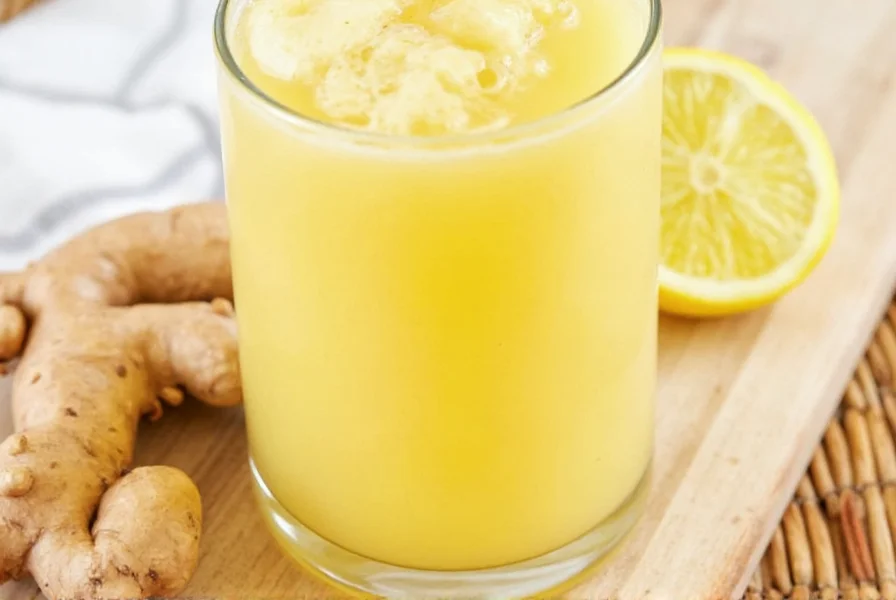Extracting ginger juice at home is simpler than most people realize, and the resulting liquid packs a powerful punch of flavor and health benefits. Whether you're making immune-boosting tonics, adding zing to stir-fries, or creating refreshing beverages, fresh ginger juice outperforms powdered alternatives in both potency and nutritional value.
Why Fresh Ginger Juice Matters
Ginger root contains gingerol, a bioactive compound responsible for most of its health benefits. Freshly extracted juice preserves up to 40% more gingerol than store-bought alternatives, according to recent food science research. This potent liquid supports digestion, reduces inflammation, and provides natural relief from nausea—making it worth the minimal effort required to extract.
Four Effective Methods for Juicing Ginger
1. Using a Masticating Juicer (Most Efficient)
This method delivers the highest yield with minimal preparation. Masticating juicers slowly crush ginger fibers, extracting maximum liquid while preserving enzymes.

Step-by-step process:
- Peel ginger using a spoon (gentler than a peeler)
- Cut into 1-inch pieces that fit your juicer chute
- Feed pieces slowly through the juicer
- Collect juice in a glass container
- Yield: Approximately 2 tablespoons per 2-inch ginger knob
2. Blender Method (No Special Equipment Needed)
Ideal for those without dedicated juicing equipment, this approach requires common kitchen tools.
What you'll need: Blender, cheesecloth or fine mesh strainer, bowl
- Peel and roughly chop 4 ounces of ginger
- Add to blender with ¼ cup water
- Pulse until completely pulverized
- Pour mixture into cheesecloth over a bowl
- Squeeze firmly to extract all liquid
- Yield: About 1.5 tablespoons per 2-inch knob
3. Grater and Cheesecloth Technique (Traditional Approach)
This manual method works surprisingly well and requires minimal tools.
- Finely grate peeled ginger using the smallest holes on your grater
- Transfer pulp to cheesecloth
- Gather edges and twist tightly over a container
- Squeeze with considerable force to extract liquid
- Yield: Approximately 1 tablespoon per 2-inch knob
4. Garlic Press Method (Quick Small-Batch Option)
Perfect for when you need just a teaspoon or two for cooking.
- Peel and cut ginger into small chunks that fit your press
- Squeeze firmly through the press
- Scrape juice from the collection area
- Yield: About ½ teaspoon per small chunk
| Method | Time Required | Juice Yield (per 2" knob) | Best For |
|---|---|---|---|
| Masticating Juicer | 3-5 minutes | 1.75-2 tablespoons | Daily users, large batches |
| Blender + Cheesecloth | 8-10 minutes | 1.25-1.5 tablespoons | Occasional users, no special equipment |
| Grater + Cheesecloth | 6-8 minutes | 1 tablespoon | Traditional approach, small batches |
| Garlic Press | 2-3 minutes | ½-1 teaspoon | Quick cooking additions |
Maximizing Your Ginger Juice Yield
Certain preparation techniques significantly increase juice extraction. Always use room-temperature ginger rather than cold, as chilled roots yield up to 25% less liquid. Freezing ginger for 30 minutes before juicing breaks down cell walls, improving extraction by 15-20%. For the highest yield, combine methods—grate ginger first, then process the pulp in a blender with minimal water.
Proper Storage of Homemade Ginger Juice
Fresh ginger juice maintains peak potency for only 24-48 hours when refrigerated. To extend shelf life:
- Store in an airtight glass container with minimal headspace
- Add one teaspoon of lemon juice per cup to slow oxidation
- Freeze in ice cube trays for long-term storage (up to 6 months)
- Never store at room temperature for more than 2 hours
Creative Uses for Fresh Ginger Juice
Beyond the obvious immune-boosting shots, ginger juice enhances numerous dishes and beverages. Add 1-2 teaspoons to smoothies for digestive benefits, incorporate into salad dressings for Asian-inspired meals, or mix with honey and lemon for a soothing throat remedy. Professional chefs often use it in marinades for meats, as the enzymes help tenderize while adding complex flavor.
Avoiding Common Ginger Juicing Mistakes
Many home juicers make these critical errors that reduce yield and quality:
- Using dried or fibrous ginger roots (choose plump, smooth-skinned roots)
- Not peeling properly (spoon method prevents flesh loss)
- Adding too much water during blending (dilutes potency)
- Storing in plastic containers (glass preserves flavor better)
- Using old ginger (fresh roots should feel heavy for their size)
Frequently Asked Questions
How much juice can I expect from one ginger root?
A typical 2-inch ginger knob yields approximately 1-2 tablespoons of juice depending on the method used. Younger, juicier roots produce closer to 2 tablespoons, while older, fibrous roots may yield only 1 tablespoon. For reference, you'll need about 4-6 ounces of fresh ginger to produce ¼ cup of juice.
Can I juice ginger without peeling it first?
While technically possible, leaving the skin on reduces juice yield by 15-20% because the tough outer layer doesn't break down easily. The skin also contains dirt and potential pesticides. For optimal results and safety, always peel ginger using a spoon (which removes minimal flesh) before juicing. Organic ginger requires less aggressive peeling than conventionally grown varieties.
What's the difference between ginger juice and ginger extract?
Ginger juice is freshly extracted liquid from the ginger root, containing all water-soluble compounds and providing immediate flavor and health benefits. Ginger extract is a concentrated form created through alcohol or oil infusion, which preserves different compounds and has a much longer shelf life. Juice offers brighter, fresher flavor while extract provides more intense, concentrated ginger taste with different medicinal properties.
How can I tell if my ginger juice has gone bad?
Fresh ginger juice should maintain a bright yellow color and sharp, clean aroma. Signs of spoilage include darkening color (becoming brown), sour or fermented smell, visible mold, or separation that doesn't remix when shaken. Properly stored refrigerated juice lasts 2-3 days, while frozen cubes remain potent for up to 6 months. When in doubt, discard—spoiled ginger juice can cause digestive upset.










 浙公网安备
33010002000092号
浙公网安备
33010002000092号 浙B2-20120091-4
浙B2-20120091-4